Recent Commercial Posts
Commercial Systems Prone to Water Damage: SERVPRO of Forsyth & Dawson Counties
4/28/2022 (Permalink)
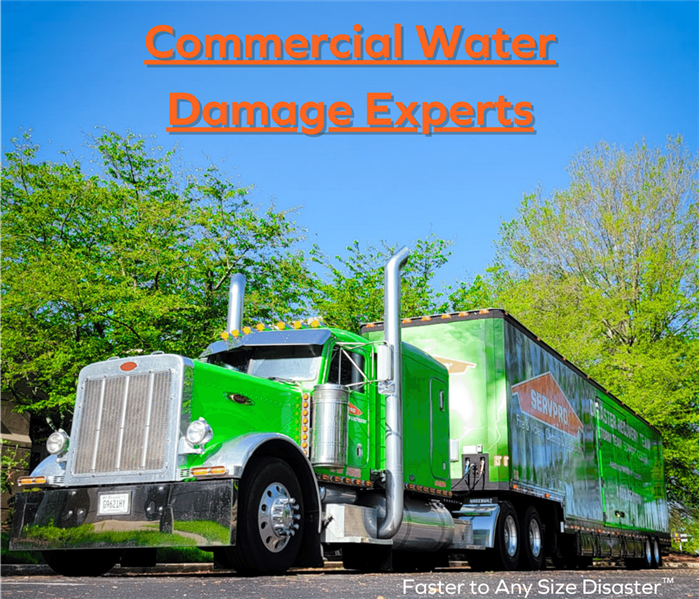 SERVPRO of Forsyth & Dawson Counties is ready for whatever happens! We'll restore your business after any size of property damage.
SERVPRO of Forsyth & Dawson Counties is ready for whatever happens! We'll restore your business after any size of property damage.
Commercial properties present unique risks when it comes to water damage in Cumming, GA. Unlike residential homes, which are usually one story and have easily accessible crawl spaces and attics, commercial buildings can be many stories high with flat roofs and multiple storefront windows. They also often have expensive specialized equipment that can be very costly to repair or replace if damaged by water. In this blog post, we will discuss the different parts of a commercial building that are at risk for water damage, as well as some tips on how to prevent it.
Plumbing Systems
The first and most obvious risk for water damage in a commercial property is the plumbing system. Because commercial buildings have more bathrooms, kitchens, and other water-using fixtures, they also have larger and more complex plumbing systems. These systems are often located in hard-to-reach places, making them difficult to repair if they spring a leak.
One of the main water damage challenges according to The Hartford Insurance is an improperly maintained sprinkler system. By law, most commercial buildings must have a fire sprinkler system, but many building owners forget to regularly maintain and test these systems. While a well-maintained fire sprinkler system can help prevent extensive fire damage in the event of a fire, improper maintenance or disaster planning can cause extensive water damage that can flood multiple floors.
Another plumbing risk is burst pipes. Commercial buildings, especially high rises tend to run at a higher pressure than residential buildings. Therefore, a burst pipe has the potential to release significantly more water than a home.
One of the ways in which we help commercial property owners prevent catastrophic property damage before it happens is through our app-based Emergency Response Planning program (ERP).
Roofing Systems
In addition to the plumbing system, there are a number of exterior commercial building components that can experience water damage. One of the most common is the flat roof. Because flat roofs are not sloped like traditional pitched roofs, they tend to pool water instead of shedding it. This can lead to leaks and eventually, if left unaddressed, major water damage.
Some common commercial roofing systems include:
- Built-up Roofing (BUR): Often called tar and gravel roofs, these commercial roofing systems are built with a semi-continuous membrane installed in layers, then covered in aggregate. While they are usually simple to maintain, best practices suggest inspecting the roof for deterioration and possible leak points at least twice yearly.
- Thermoplastic Single-Ply Membrane Roofing (PVC & TPO): These roofs are installed in large rolls that are then welded together at the seams with heat. The material is very durable and oil-resistant. However, the heat-welding methods require skilled installation, which can lead to weak points and leak-prone areas if not performed correctly.
- EPDM Roofing: Some roofers call these "rubber roofs" because the material they are made of, ethylene propylene diene monomer is very rubber-like. This kind of roof is derived from oil and natural gas, and appears dark gray or black. When installed correctly and with the highest thickness available, this type of commercial roof will last a very long time with little to no issues. Unless you experience storm damage in your area, an annual check for leaks around the roof penetrations should suffice.
Window Systems
Commercial window systems are built for durability and use, however, they can often present a unique water damage challenge for commercial facilities. Most aluminum glazing systems aren't intended to be 100% waterproof. Most commercial window systems are meant to limit water penetration during extreme circumstances while also weeping water back out to the exterior.
By directing all moisture to the sill flashing, storefront systems limit water penetration. It's critical that the sill flashing be installed correctly in order to avoid water damage. Making sure that sealant is put on the top of the rear leg before installing the sill is one of the most important aspects of a good installation.
The most essential aspect of maintaining water penetration with a storefront is end dam fastening and sealing. Water will enter the building through the jamb locations if end dams are not properly fastened and sealed. Improperly (or missing) end dams can cause significant water damage to the interior drywall or flooring around commercial storefront windows.
Like anything else in a building, time and the elements can cause wear and tear and failure of these commercial window water control systems.
Commercial Water Damage Inspection Services
So if you notice moisture or water damage around your storefront windows, you should consider calling SERVPRO of Forsyth & Dawson Counties to inspect for potential water damage issues. Our technicians are trained to identify, troubleshoot, and restore all types of commercial water issues.
Call today to schedule your commercial service!
(770) 887-1962
Have a Commercial Kitchen? Reduce Fire Risk with These Tips
12/23/2021 (Permalink)
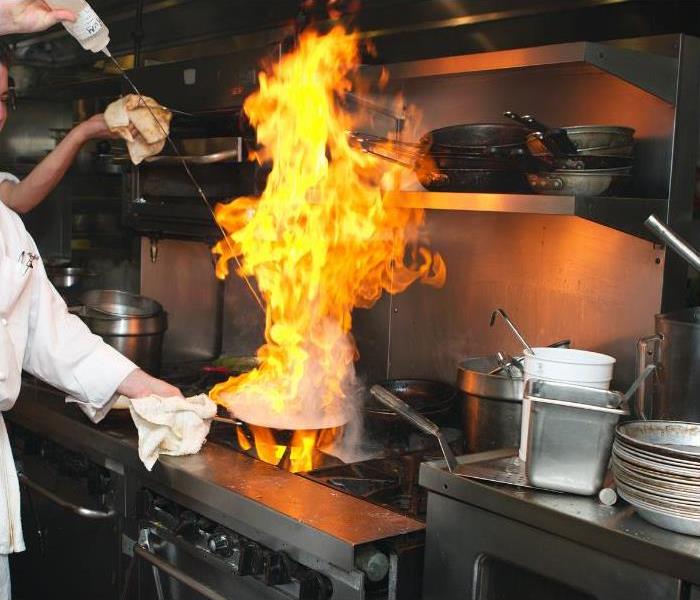 Commercial Kitchen Fire While Cooking
Commercial Kitchen Fire While Cooking
If you own a restaurant, bar or commercial kitchen in Cumming, GA or Chestatee, GA, reducing fire risk is critical to continued profitable operation. The National Fire Protection Association (NFPA) reports that fire departments responded to over 7,410 structure fires in the kitchen of restaurants and bars in 2017 alone. Most of these fires were preventable, resulting in three deaths, 110 injuries, and $165 million in property damage annually in commercial kitchens. These tips will help keep you and your staff safe while preventing shutdowns due to fire code violations.
What Are My Ducting and Air Movement Requirements to Prevent Fire?
While Chapter 7 of the NFPA 96 Standard for Ventilation Control and Fire Protection of Commercial Cooking Operations covers this extensively, here are a few key items to keep in mind.
First, commercial kitchen ducts should never pass-through firewalls, share an exhaust system with the building ventilation, or have obstructed access panels. While doing these things on a commercial kitchen remodel can save costs in the short term, the fire risk increases significantly. If disregarded, your commercial kitchen work will likely not pass inspection.
Make sure to maintain a minimum clearance of 18 inches between combustible materials and the kitchen ducts. This standard is based on Section 4.2 of the NFPA 96, however is one of the easiest to disregard once the kitchen is operational. Ducts can build up high levels of radiant heat that can ignite combustible materials like boxes, cups, plates, utensils, or other kitchen materials.
If you would like additional information on the types of combustible and non-combustible materials that should and shouldn't be kept near the duct, consult Chapter 3 of the NFPA.
What Are My Commercial Kitchen Fire Extinguisher Requirements?
"The NFPA 96 requires automated fire suppression equipment for all grease removal devices, hood exhaust plenums, and exhaust duct systems in a commercial kitchen, as well as any cooking equipment that produces grease-laden vapors." - Koorsen Fire & Security
The NFPA 96 requires use of class K fire extinguishers in conjunction with automatic fire extinguishing systems. These extinguishers also require installed placards stating their extinguisher class. However, in the case of a commercial kitchen fire, it's critical to activate the automatic fire extinguisher system before using portable-type extinguishers. This is because high-efficiency cooking appliances in many modern commercial kitchens are capable of achieving high temperatures that can raise the vegetable oils to intensely high temperatures. When oil ignites at these high temperatures, it can already be so hot that a portable extinguisher is not enough to stop the flames.
Another standard that you should familiarize yourself with is the UL 300 standard.
According to this article by Insureon, a kitchen’s cooking equipment must meet these UL 300 requirements:
- Fire-extinguishing nozzles in the hood, ducts, and above each cooking appliance
- An automatic fuel shut-off capabilities for both gas and electric power sources
- A manual fuel shut-off pull for all power sources
- A wet-chemical fire-extinguishing system that meets UL 300 criteria (one of which is undergoing semiannual checkups by a certified professional)
If you need immediate assistance after a fire, our teams are available 24/7/365. With our promise of being Faster to Any Size Disaster, you can count on SERVPRO of Forsyth & Dawson Counties to be there when it counts. Call us today at (770) 887-1962 for rapid assistance.
Understanding Commercial Property Insurance Coverage
10/27/2021 (Permalink)
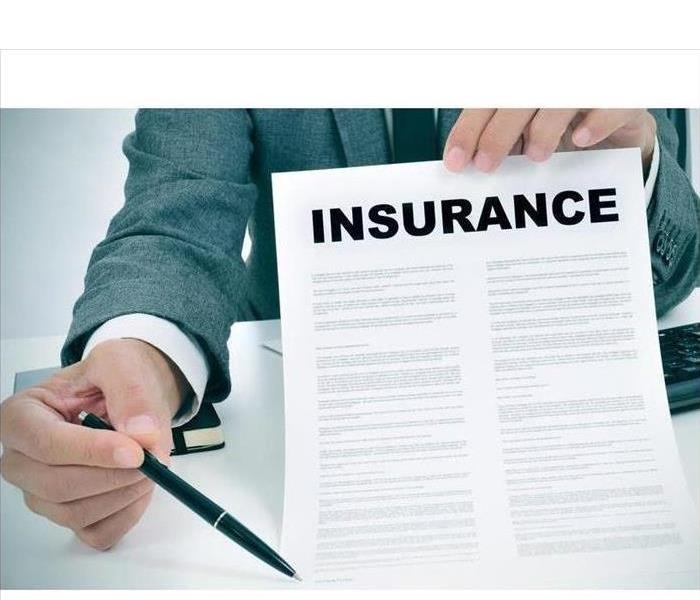 What’s covered under commercial insurance depends on the package you choose.
What’s covered under commercial insurance depends on the package you choose.
Commercial Property Insurance
Commercial property insurance can be a highly complex topic that some business owners struggle with. What’s covered? What isn’t covered? What affects the costs of your premiums by driving them up or driving them down? Let’s take a look at what commercial property insurance looks like for property owners in Jasper, GA.
What’s Covered Under Commercial Property Insurance
Many times, what’s covered under commercial insurance depends on the package you choose. You may choose a bare minimum package that only covers liability for any damages not of your own making, or you may choose a more extensive package. Some things you can cover with commercial property insurance include:
• Structural damage caused by fire, accident, or natural disaster
• Theft of property or inventory
• Damage caused by trespassers or vandalism
• Fire, flood, or accident damage to equipment, furnishings, and inventory
• Personal injury liability on premises
What Brings Your Premiums Up
Multiple factors may impact why a commercial insurance provider would raise premiums on your building. If you live in an older building with a high risk of fire, for example, you may pay more for insurance. Your industry also matters; a restaurant has a much higher chance of fire than a daycare center. Neighborhood and proximity to fire services and police services can also play a role.
What Drives Your Premiums Down
That said, commercial insurance providers can also help you find ways to bring your premiums down. Just installing a security system can be enough to bring your premiums down by reducing your likelihood of theft or unwanted intrusion. If your building is constructed from newer fire-retardant materials, you may also see a drop in premiums.
The location once again has an impact, and the closer you are to fire and police services the lower your premium can be. Lastly, if your business is in a low-risk industry that doesn’t frequently have hazardous materials or situations on the property, you can hope to enjoy lower premiums.
Mold 101
7/26/2021 (Permalink)
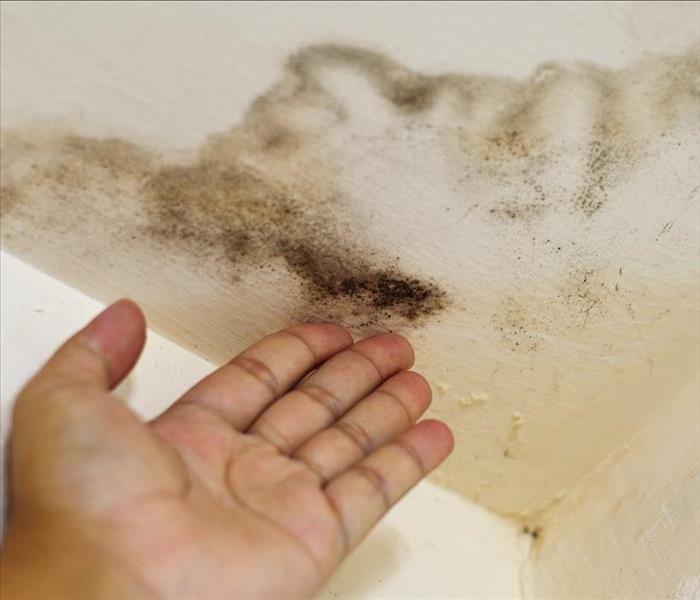 Mold should not take up residence in your building.
Mold should not take up residence in your building.
Types of Molds and How To Identify Them
In short, mold is a fungus that helps to decompose dead plants and animals by breaking down carbon material. Mold spreads through the air via spores that attach themselves to any source of food. Their spores can also grow indoors. One of the most infamous is Stachybotrys, also commonly known as “black mold.” However, this is not the only mold that can find its way into buildings. Although the exact number of species is still unknown, scientists estimate that there are thousands. Many can affect your business in Talking Rock, GA. Here are some of the most common kinds and how to identify them.
1. Aspergillus
Aspergillus is frequently found wherever dust accumulates. It typically has a brown or dark-green color. Different places this mold can spread are floors, wallpapers and air filters. Certain species are also found on food.
2. Stachybotrys
Stachybotrys earned its nickname, black mold, through its distinctive greenish-black gel-like appearance. Like many fungi, it can spread in any area with a moisture problem. That is why it is frequently found in restrooms or on walls in rooms that have experienced flooding. While some species may not pose a large threat to public safety, you can check with a reputable mold cleanup service to inspect your property in order to identify whether professional removal is necessary.
3. Cladosporium
Cladosporium can also spread in areas of high moisture. Colonies can grow in bathrooms, in basements and on any wood surface. Typically, you can spot this type of mold by its green or brown color. While it is possible to remove this type of mold yourself, calling qualified mold experts can assist in its disposal.
In nature, mold serves a natural purpose in the ecosystem. However, mold, especially black mold, should not take up residence in your building. Learning how to identify mold and who to call when you face an infestation will help you safeguard your business’s future.
Responsibilities of a Commercial Tenant During a Rental Flood
6/25/2021 (Permalink)
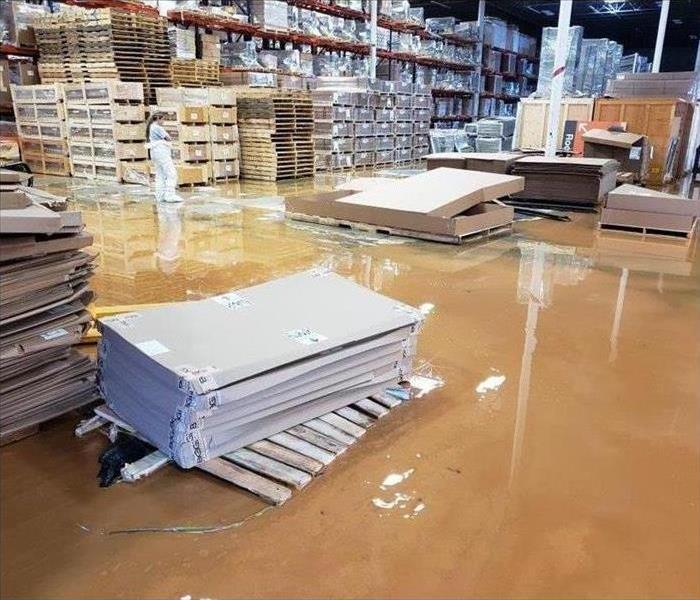 Flood damage in a Jasper, GA warehouse.
Flood damage in a Jasper, GA warehouse.
Responsibilities of a Commercial Tenant During a Rental Flood
When a flood hits your rented business property in Jasper, GA, you may be wondering who is liable for the damage. It may depend on the circumstances of local law and lease agreements, but it’s often like a residential lease. Knowing what coverage is offered to a tenant by renting and what’s covered by renter’s insurance teaches you your legal responsibilities if a flood happens.
Lease, Law, and Understanding
In a traditional lease, the process of addressing damage is often by a standard procedure:
- A tenant pays lower amounts to occupy a property while the owner handles any damages to the property that is explicitly not the tenant’s fault.
- If there is an unsafe condition or damaged part of the property caused by a flood or other event, the tenant has an obligation to write the landlord about it.
- The landlord has an obligation to repair any reported problems in a timely manner.
Depending on state law and the language of a commercial lease, all repairs may fall on the tenant. It is advised to consult the original lease to see any specified conditionals on flooding and other damage. Some states have laws or court rulings that establish the landlord’s responsibility regardless.
For Everything Not Covered, There’s Other Coverage
The landlord has no obligation to cover property inside the building. It is up to the commercial property’s occupant to obtain renter’s insurance to protect assets inside. As a standard, this insurance coverage offers protection against unintentional damage alongside vandalism and theft. Sometimes, flood damage is not included and offered as an additional service, but it is advised in regions prone to flooding.
Restoring the Building Once Coverage Is Figured Out
Renter’s insurance is used to restore and replace damaged business assets or the building. Restoration is typically accomplished by using a commercial damage restoration company. Working out the coverage with the property owner will speed the damage restoration process up to get your business’ location restored and functional quickly.
3 Ways To Save Your Belongings After a Fire
4/19/2021 (Permalink)
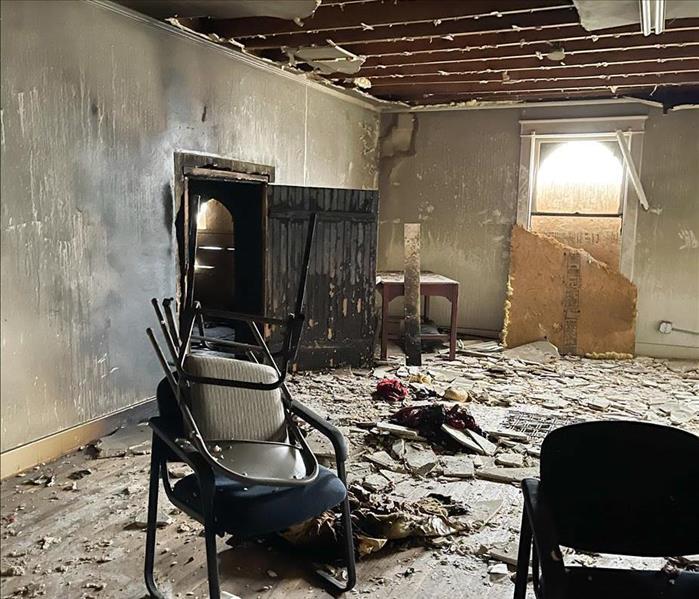 Fire damage in Cumming, GA.
Fire damage in Cumming, GA.
How To Proceed In The Wake Of A Fire
Experiencing a structural fire is undoubtedly a nightmare realized. Not only is the affected building potentially destroyed, but your belongings inside appear to be beyond restoration. If your personal possessions are affected by smoke damage, there is hope for recovery.
1. Determine What Is Restorable
Ideally, restore the majority of your possessions harmed in the fire versus replacing them. Family heirlooms and irreplaceable keepsakes specifically should be carefully treated to avoid total ruin. Several techniques exist to combat smoke damage and smoke odor:
- Dry and Wet Cleaning
- Spray and Wipe
- Foam Cleaning
- Abrasive and Immersion Cleaning
Depending on the damage, many or all of these smoke cleaning methods can assist in the restoration process.
2. Prepare To Move Out
Often, a structure in Cumming, GA, remains unlivable until the extent of necessary smoke cleaning is complete. In this case, companies exist to assist you in a temporary relocation during your home's refurbishment.
Not only is it unsafe to live in a house laden with smoke odor, but it is much easier for the professionals to complete the fire restoration process without working around other individuals and their schedules.
Once the cleaning is complete, the same company can help you move back into your clean, safe home. This assistance provides comfort and ease in a time of crisis and trauma.
3. Beware Of Electronics
Fire presents a host of dangers where your electronics are concerned. As such, never attempt to plug in or operate any of your appliances following a fire. Always contact an electrician to inspect your wiring, outlets, and electronics before activating them post-fire. If necessary, a professional can accurately and safely clean any remaining smoke residue, allowing you safe use of your personal devices.
While damaging and frightful, fires do not always cause ruin beyond repair. By following the correct smoke cleaning steps, your belongings can survive even the most dangerous of blazes.
4 Common Causes of Tile Mold
2/2/2021 (Permalink)
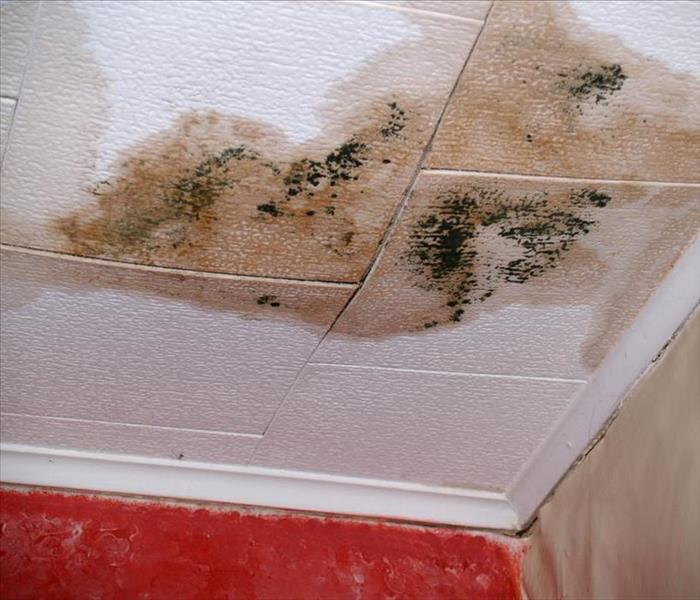 Mold damage on ceiling tiles
Mold damage on ceiling tiles
4 Common Causes of Tile Mold
Finding tile mold in your Cumming, GA building can be disconcerting. While it reveals a fungus problem, you may be in the dark as to how it began. If you want to know how the mold could have formed, here are four common causes of moldy tiles.
1. HVAC Systems
One of the most common causes of tile discoloration is HVAC (heating, ventilating, and air conditioning) leaks. These are a few possible causes for such leaks:
- Clogged drain pipes
- Incorrect maintenance
- Flawed installation
If you find this source of mold, the first step is to turn off your HVAC systems. This prevents further leakage and minimizes the spread of moisture.
2. Vents
Your building may have roof vents for plumbing or air. If this is the case, the area around these vents might be less secure than the rest of the roof. You can pinpoint this cause of water damage by looking for stains around the openings.
3. Roof Flashing
If your roof has a horizontal surface that meets a vertical surface, chances are that you have roof flashing. These are thin pieces of metal that protect important sections of the roof by guiding water away. Flashing may also be installed around holes such as chimneys and skylights. If your flashing isn't working properly, you may get tile mold from these protected areas.
4. Leaking Pipes
The mold on your tiles may be continuously growing over time. This could be due to a leaking pipe, which might consistently drip small amounts of water onto your ceiling tiles. It's especially possible if your building is in a temperate climate or has old pipes. While moldy tiles are generally caused by roof leaks, this could also be an explanation.
Tile mold is never pleasant to find. However, it may be simple to fix. Remember to call a mold remediation company to be certain that it's eradicated.
3 Steps To Take After a Furnace Puffback
12/28/2020 (Permalink)
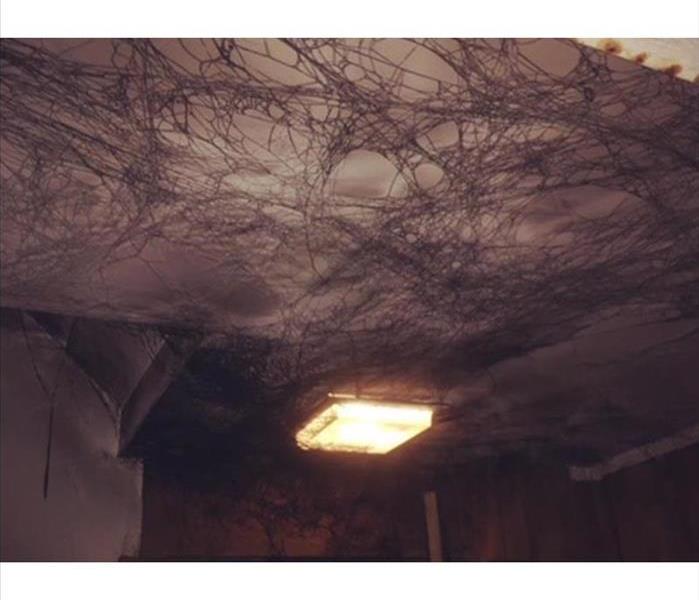 A furnace puff back can create an enormous mess in your building
A furnace puff back can create an enormous mess in your building
Take These Steps To Deal With Puff Backs The Right Way
When a furnace isn’t working properly, fumes and fuel can accumulate in the combustion chamber and ignite, causing a small explosion that forces soot and smoke through the exhaust vents. This occurrence is known as a furnace puffback. A puffback is a cry for help from your building’s furnace, although you could be the one crying when you see the puffback damage to your building. Don’t try to clean this mess up yourself: Take these steps to deal with puff backs the right way.
1. Call a Repairman
Your first step should always be to call a Dahlonega, GA, HVAC professional to repair your building’s heating system. Puffbacks do not occur when furnaces are functioning correctly. Ignoring the problem will likely lead to more mess and possibly even a fire or explosion.
2. Call Your Insurance Company
Inspect the building thoroughly to assess the damage. Soot from a puffback can travel a surprising distance and cover a huge area. It can spread even further by traveling through your building’s ductwork. Puffbacks can leave large black streaks or a fine layer of soot on just about everything, including inside drawers or behind closed doors. Your property insurance may cover the cost to clean up the puffback damage.
3. Call a Professional Cleanup Crew
Never try to clean up the mess from a puffback yourself. Soot is a unique substance that does not simply wipe away like dust. The sticky, oily soot from an oil furnace is particularly challenging to remove, and without professional equipment and training, your cleanup efforts could end up causing more damage. Contact a reliable restoration service with experience dealing with soot damage. These professionals will use the correct cleaning agents and techniques to fully remove soot and soot odor from your building.
A furnace puffback can create an enormous mess in your building. Dealing with puffback damage is frustrating, but restoration professionals have the tools to get your building looking “Like it never even happened.”
4 Sources of Construction Water Damage and How To Avoid Them
12/15/2020 (Permalink)
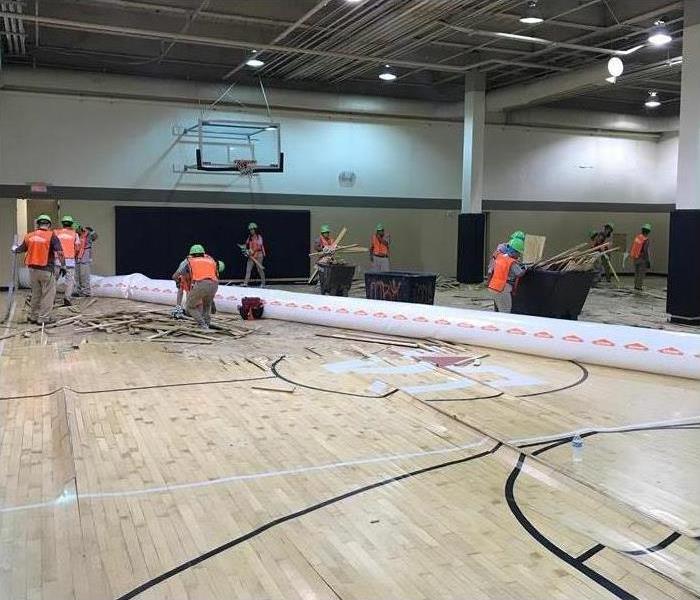 Wood floors damaged by water in Cumming, GA
Wood floors damaged by water in Cumming, GA
Below Are Four Common Problems That Arise And Ways To Avoid Them
Expanding and beginning new construction on a building for your Cumming, GA, business is an exciting time, but it can also be nerve-wracking. If damage happens early on, such as a water pipe repair, it may result in issues down the road. Having a plan in place to mitigate potential water issues that require extensive repairs by a water damage and restoration company is essential. Below are four common problems that arise and ways to avoid them.
1. Unsecured Openings
No matter how safe and secure the site is, Mother Nature is notorious for bringing unwanted weather. Throughout the process, openings, such as windows, doors and elevator shafts, present the perfect opportunity for the construction site to become flooded. Along with keeping an eye on the weather, ensure a checklist is in place to protect those openings. That may include a temporary roof and boarding up windows.
2. Faulty Pipe Installation
An improper connection or plumbing installation will mean facing a water pipe repair down the road. If the system isn’t properly insulated, it may mean dealing with a broken pipe. Testing the system is a vital step. Flow alarms can be activated to help detect any leaks.
3. Site Drainage Issues
If pooling water seems commonplace on the site, you may be facing a blocked or inefficient drain. To avoid that, ensure surrounding soil is properly graded and backfill exposed areas. It may be necessary to put sandbags around the area. Drain screens should also be used to minimize the construction debris causing further issues.
4. Material Storage
Various materials are used in the construction process, and many of them are susceptible to water damage. If rainy weather is on its way, items not properly stored can lead to a building built with pre-damaged components. Ensure the contractor has a plan for storage and uses just-in-time delivery as often as possible. If they must be stored on-site, try and keep them indoors and covered.
The last thing you want to worry about after opening the doors to your new building is a water pipe repair. Formulating a plan and protecting the construction site can minimize issues from happening.
3 Tips for Effectively Handling Water Damage in Your Commercial Property
11/11/2020 (Permalink)
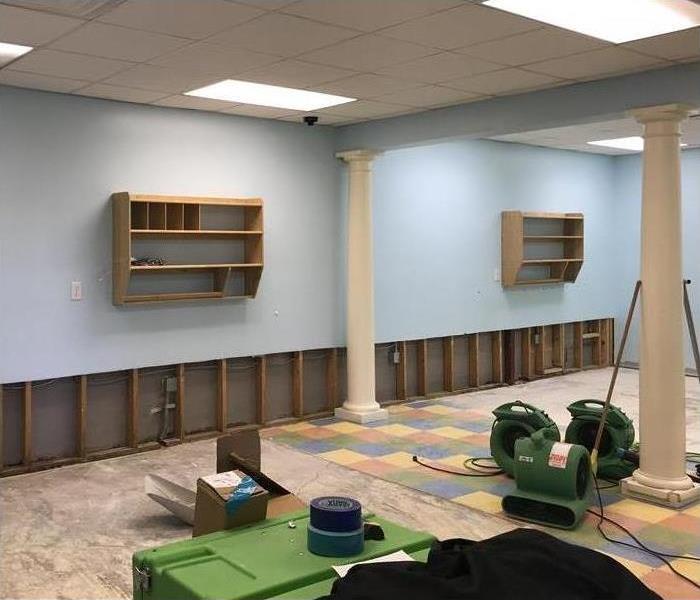 Dry your building out using fans or dehumidifiers
Dry your building out using fans or dehumidifiers
Here Are Three Tips For Handling Water Damage
Water damage is not an uncommon occurrence in the business world. Besides the ever-present risk of a natural disaster like a hurricane, there can be harm done to property by everyday problems like broken pipes. In the event your commercial property in Mcdaniel, GA, ever suffers from an unexpected flood, it is important to know how to handle it. It is generally recommended that a professional cleanup and restoration service be employed for water cleanup, building restoration and content repairs, but there are some steps business owners can take themselves in the aftermath of a water disaster while waiting for the professionals.
1. Contact Your Insurance Company
It is important to call your insurance company as soon as possible after an event resulting in water damage. It takes time for insurance companies to process claims, and the order in which claims are made does not necessarily determine the order in which they are paid out. The sooner you get the ball rolling, the better.
2. Prepare for the Insurance Adjuster's Visit
After speaking with the insurance company, you should prepare for a visit from an insurance adjuster, the person who will determine how much you receive from your insurance policy. Being ready can speed up the claim process and ensure you get the amount your policy entitles you to. Here are some steps you should take in preparation:
- Create an itemized list of damages and lost contents.
- Take pictures of the damage.
- Read every detail of your policy closely.
3. Cleanup Where Possible
Even before the professional restoration company has arrived, you should begin the recovery process by cleaning up what is safe to. This includes starting to dry the building out using fans or dehumidifiers and removing standing water if possible. If the water continues to flow from a source you can stop, you need to stop it, whether that means calling a plumber or turning off the water at the main supply line.
Water can devastate property. Water cleanup should begin as soon as possible to minimize harm, so consider following these tips as you handle your flooded property.
3 Reasons To Choose a Mitigation Company To Rebuild Your Business
8/25/2020 (Permalink)
If your property in Holcombe, GA, sustains fire damage, mitigation and restoration will likely be priorities for you as a business owner. Businesses often hire separate companies to provide mitigation and restoration services. However, there are several benefits to employing the same company to provide both immediate loss prevention and any follow-up repairs and renovation.
1. A Quick Response
When your business has been affected by a fire, you likely will want mitigation and restoration efforts to begin as quickly as possible. However, it can be time-consuming if you have to contact two separate companies and schedule a time when each company can visit your building. A mitigation company that also performs restoration can provide you with a timely assessment of your business. A single company can also quickly provide your insurance adjuster with information about the state of your business.
2. Excellent Communication
After your business has sustained fire damage, it can be frustrating to go back and forth between a mitigation company and a restoration company. Communication is essential during the mitigation and restoration process. If two companies are unable to communicate with one another well, this can cause both processes to come to a halt. However, using a fire mitigation and restoration company can help to ensure that no important details are overlooked, ultimately helping your business to reopen more quickly.
3. Effective and Thorough Mitigation and Restoration
Hiring two different companies to mitigate the damage and restore your business could mean the quality of work may vary. Each company will likely have its own set of standards, and hiring an excellent mitigation company and a sub-par restoration company, or vice versa, could result in an unsatisfactory result. When you hire an experienced company to mitigate damage and restore your property, however, you can trust that you will receive consistent, high-quality results.
A mitigation and restoration company can respond quickly to a disaster, communicate effectively, thoroughly mitigate the damage and restore your business. Choosing a mitigation company to restore your business after your property has sustained fire damage can ultimately help to save you time, money and stress.
 SERVPRO of Forsyth & Dawson Counties is ready for whatever happens! We'll restore your business after any size of property damage.
SERVPRO of Forsyth & Dawson Counties is ready for whatever happens! We'll restore your business after any size of property damage.





 24/7 Emergency Service
24/7 Emergency Service








